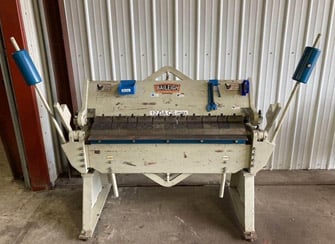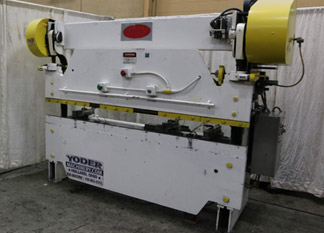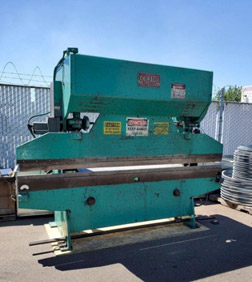A brake is a metalworking machine that bends sheet metal. In the metalworking industry, brakes are also known as bending brakes or bending machines. Bending is a manufacturing procedure that may produce several shapes, including channel, U, and V shapes.
Metal-bending brakes come in various sizes and types, each with its own set of benefits and drawbacks. Before operating a brake, operators should be aware of tolerances, tooling types, and other issues.
Main Parts of a Sheet Metal Brake
A brake consists of a flat surface on which the metal material is placed and a clamping bar that drops down to firmly hold the material in place throughout the bending process. This clamping action can be done manually, automatically, or with a foot pedal. In addition, the front, gate-like plate of the machine is hinged and may be lifted, forcing the material extended over the straight edge to bend to follow the plate.
Bends can be made at any angle up to approximately 120 degrees or more in the case of a bar folder. If the area to be bent is small enough, you can achieve a sharper bend by placing the curve under the clamping bar and lowering it.
Essentially, a sheet metal brake has four essential components: the bed/table, beam/clamp, apron, and cam. All these parts work together to bend metal materials into desired shapes.
- Bed/table – The flat surface of the machine
- Beam/clamp – The moveable top which clamps the metal or material to the bed or table
- Apron – The front, gate-like plate that is lifted to shape the metal or material
- Cam – The part that is used to adjust the clamp pressure against the table
Popular Types of Metal Brakes
There are CNC press brakes, hydraulic press brakes and mechanical press brakes. The most popular types of metal brakes are:
Cornice or Leaf brake
Cornice or leaf brakes are used to bend and fold large metal sheets; however, they are typically only used for minor bends. For example, a sheet of metal is fastened to a stationary, flat surface and kept in place with the help of a clamping bar using a cornice brake. The metal sheet can then be adjusted using a bending leaf, which presses the sheet over the clamping bar and shapes it.
While this approach is easy and effective for generating somewhat precise bends to the edges of sheet metal panels, the types and nature of bends that may be made are limited with this sort of bending brake.
Box/Pan/Finger brake
A box and pan brake, also known as a finger brake, is another type of metal brake. These types of brakes enable the production of more intricate bends and shapes (boxes and pans) that would be impossible to achieve with a straight or limited-function cornice brake. These devices have movable “fingers” that may be adjusted to change the shape of the box and pan bends that the machine produces.

Bar folder
This is a more basic brake than the cornice or box-and-pan brakes, which are usually much smaller. In most cases, a single handle clamps the workpiece and bends it in one swift motion, but the depth is generally less than that of a cornice or a box-and-pan brake.
Press brake
This type of brake is a machine that bends sheet and plate material using a pressing tool. It clamps the workpiece between a matched punch and a die to create predefined bends.
The sides of the press brake are usually formed by two c-frames, which are connected to a table at the bottom and a moveable beam at the top. The top tool is attached to the upper beam, while the bottom tool is positioned on the table.
Press brakes are typically defined by the width of the material they can bend and its either measured by “gauge” or “inches”.
Box and Pan Brake vs. Apron and Hand Brake
Hand brakes are used to bend sheet metal into tight straight bends of various degrees. In sheet metal manufacturing, there are two types of hand brakes used to make bends– a sheet metal brake and a box and pan brake. Although they both bend sheet metal and have similar components, they are different in the type and number of bends they can produce.
When only one or two bends are needed, a sheet metal brake is the most helpful hand brake in the sheet metal industry. However, the sheet metal brake can also be utilized for the third bend on rare occasions. The length capacity of sheet metal brakes distinguishes them from the others, and the clamping leaf and the bed are the same lengths.
Meaning, an eight-foot brake has a clamping leaf that is eight feet long and has an eight-foot capacity. However, sheet metal brakes have one significant flaw. The length and angle of the clamping die limit the types of bends that a sheet metal brake can make.
The box and pan brake shine where the sheet metal brake fails. As its name implies, the box and pan brake are used to bend sheet metal boxes and pans. The clamping die on a box and pan brake are removed and replaced with fingers, unlike sheet metal brakes. Clamping fingers come in a variety of sizes and can be simply added or removed as needed.
This allows you to modify the top die’s width to the width required for many bends on a sheet of metal. The locking bolts on top of the fingers wear out when they are removed and replaced frequently, and this might lead to shifted or misaligned fingers because of the looseness. Sheet metal bends will have uneven patches if this happens.
Hydraulic Press Brake vs. Mechanical Press Brake
For punching and creating sheet metal components, hydraulic press brakes are simple to use and versatile. A hydraulic press’s tooling is straightforward, and its handling costs are low. Mechanical Press Brakes can only be used for stamping materials that have an inside radius less than the material thickness which is called coining. They typically have the highest stroking speeds with high accuracy and repeatability with a low cost. However, Hydraulic presses have an advantage over mechanical presses because they do not require expensive dies or components and have tremendous forming capacity.
Another benefit of using a hydraulic press is that it is easy to set up since it does not require additional forming functions. The hydraulic brake can perform a hydroforming operation that is impossible on a mechanical press brake because it does not have speed control. As a result, it cannot remain on the bottom for carrying out the high-pressure forming operations.
A hydraulic press brake also allows for dwelling and ram speed control, which is not available with a mechanical press brake. Additionally, you can program hydraulic presses to adjust the ram speed and position, while mechanical presses lack this capability.
In the end, hydraulic press brakes produce precise and high-quality goods. As a result, hydraulic presses are currently used in a wide variety of projects in various industries.

from Yoder Machinery Sales

What to Look for When Buying Metal Brakes
With so many makes, models, sizes, and choices to choose from, finding the correct press brake for your shop can be challenging. Before you begin your search and purchase a metal brake machine, you should consider a few factors:
- The type and thickness of the material you need to bend
- The complexity of the bends
- The accuracy of the bends
- The number of bends needed
Once you have determined these characteristics, you are one step closer to purchasing your new or used metal brake press.
Applications and Industries
The possibilities for using a brake for metal bending are limitless. They are used in a wide range of industries, including transportation, automotive, aviation, and agriculture. Here’s a sampling of items that can be created by a variety of brake types:
- Gutters
- HVAC ducts
- Custom metal flashings
- Metal roofs
- Vents
- Fascia boards
- Drip edges
- Car bumpers
Accessories
Few accessories can be added to your machine, and these accessories can provide you with more bending, cutting, and fabricating options that will assist in helping you build new or custom parts. You can also use these accessories to aid in the repair and reconstruction of existing equipment.
- 22-gauge brakes
- Radius brakes
- 52″ foot shear brakes
- Apron stop (adjustable)
- Back gauge kits
- Finger kits
- Replacement parts
- Metal forming and manual metalworking tools
Tips for Finding and Buying Metal Brakes
When buying a metal brake, it’s always best to use a trusted source. Once you’ve determined the type of brake you or your business needs, finding one on Surplus Record is easy! With our newly redesigned website, searching is easier than ever. You can use the search bar in the header of our website to perform a basic search. Simply type in “brakes” or narrow it down by a specific type.
We also work with a variety of dealers who specialize in brakes. You can find dealers in your area or by name who specialize in a variety of metal brake types. Top manufacturers include Cincinnati, Pacific, Accurpress, Wysong, and Amada.
Trust The Best Metal Brake Dealer Around
Surplus Records has always been committed to helping businesses sell surplus and unwanted equipment. For almost a century, Surplus Record has championed machinery dealers in North America, assisting thousands of dealers and individual sellers in connecting with end-user consumers to sell surplus machinery and equipment.
Surplus Record’s comprehensive database of surplus, new, and used equipment is a terrific place to start if you’re currently in the market for new tools or machinery.

